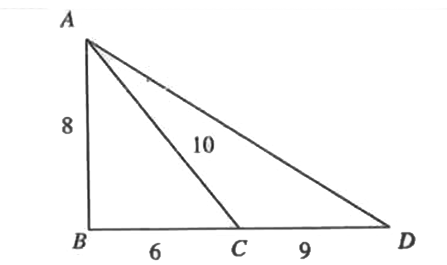If a=10, b=4, c=6, d=9, find :-
(i)adbc
(ii)ad×bcSolution in Gujrati
The correct Answer is:(i)154
(ii) 2160
Step by step video & image solution for If a=10, b=4, c=6, d=9, find :- (i)(ad)/(bc) (ii)ad xx bc by Physics experts to help you in doubts & scoring excellent marks in Class 12 exams.
Updated on:21/07/2023Topper's Solved these Questions
- RACEBOOK - ALLEN CHAPTER - RACEEXERCISE - Basic Maths (VECTORS)
62 Videos
- RACEBOOK - ALLEN CHAPTER - RACEEXERCISE - Basic Maths (Units, Dimensions & Measurements)
37 Videos
- RACEBOOK - ALLEN CHAPTER - RACEEXERCISE - Basic Maths (Graphs))
28 Videos
- NEWTONS LAWS OF MOTIONBOOK - ALLEN CHAPTER - NEWTONS LAWS OF MOTIONEXERCISE - EXERCISE-III
28 Videos
- SIMPLE HARMONIC MOTIONBOOK - ALLEN CHAPTER - SIMPLE HARMONIC MOTIONEXERCISE - Example
1 Videos
Similar Questions
State whether the following relations are true or false
(1)−−→AB=−−→BA
(2)−−→AB=−−−→BA
(3)∣∣∣−−→AB∣∣∣=∣∣∣−−→BA∣∣∣
(4)∣∣∣−−→AB∣∣∣=∣∣∣−−−→AB∣∣∣
(5)ˆj=ˆk
(6)∣∣ˆj∣∣=∣∣ˆk∣∣
View SolutionWhich one of the following is not a fundamental quantity ?
View SolutionWhich of the following equation is best representation of following graph's?

View SolutionAssertion: The driver in a vechicle moving with a constant speed on a straight road is in a non-inertial frame of referance.
Reason: A reference frame in which Newton's laws of motion are applicable is non-inertial.
View SolutionA rod with rectangular cross section oscillates about a horizontal axis passing through one of its ends and it behaves like a seconds pendulum, its length will be
View SolutionIn Figure (i) and (ii), DE||BC. Find EC in (i) and AD in (ii).

View SolutionThe system of linear equations ax+by=0,cx+dy=0 has a non trivial solution if (A) ad+bc=0 (B) ad−bc=0 (C) ad−bc,0 (D) ad−bc.0
View SolutionA(1, 1), B(7, 3) and C(3, 6) are the vertices of a △ABC. If D is the midpoint of BC and AL BC, find the slopes of (i) AD and (ii) AL.
View SolutionIf a:b=c:d, then prove that a+ba−b=√ac+ad+bc+bd√ac−ad−bc+bd.
View Solutionयदि A=[abcd] हो, तो सिद्ध कीजिये कि A2−(a+d)A+(ad−bc)I=O
View Solutionसिद्ध कीजिए कि:
∣∣∣ad+bcbd−acac−bdad+bc∣∣∣=(a2+b2)(c2+d2).
View SolutionIn Fig , (i) and (ii) , DE∣∣BC . Find EC in (i) and AD in (ii).

View SolutionIn the figure, if AB=8,BC=6,AC=10andCD=9, then AD =

View SolutionIf A = ((a,b),(c,d)) , such that ad - bc != 0 then A^(-1) is :
View Solution(i) ರಲ್ಲಿ (ii) ರಲ್ಲಿ DE || BC ಆದರೆ (i) ರಲ್ಲಿ EC (ii) ರಲ್ಲಿ AD ಕಂಡು ಹಿಡಿಯಿರಿ.


View SolutionIn the following figures DE || BC.
(i) Find EC (ii) Find AD

View Solution
